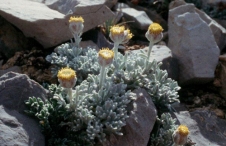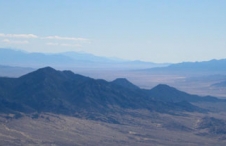Singleleaf Pinyon
Singleleaf pinyon (Pinus monophylla) dominates much of Nevada's pinyon-juniper woodlands and is Nevada's state tree along with the Great Basin bristlecone pine, which is not as widely represented geographically nor as important with respect to prehistoric and historic human use. Singleleaf pinyon is found in association with Utah juniper (Juniperus osteosperma) over much of its range and occurs with curlleaf mountain mahogany (Cercocarpus lediofolius) at higher elevations. Singleleaf pinyon's geographic range is centered on Nevada, and it is replaced to the south and east by the two-needled Colorado pinyon (Pinus edulis).
Singleleaf pinyon is the most xeric, or dry-adapted, pine species in North America and typically occurs on rocky slopes, ridgetops, and alluvial fans. It may have arrived at the northern extent of its range quite recently and has been expanding into valley floors and canyon bottoms in recent decades. The species is very rare north of the Truckee and Humboldt rivers.
Singleleaf pinyon is unique among pines in having a fascicle (needle bundle) of only one needle, hence its common and Latin names. It is short-statured—typically ten to thirty feet tall—but can achieve large diameters. It is slow-growing and requires thirty to sixty years for reproductive maturity, and it can achieve ages in excess of 800 years. Old-growth pinyon pines develop twisted and gnarled forms that are similar to bristlecone pines.
The singleleaf pinyon's large, nutritious seed contains all twenty amino acids as well as several vitamins and substantial quantities of polyunsaturated fatty acids. Many birds and mammals eat pine nuts, and the pinyon pine is largely dependent on dispersal by Pinyon Jays (Gymnorhinus cyanocephalus) and Clark's Nutcrackers (Nucifraga columbiana) that cache the seeds for use in winter. Pinyon also provides valuable cover habitat for numerous game birds and grazing mammals, particularly where it is intermixed with other vegetation types that provide good forage.
The oldest paleoecological records of singleleaf pinyon in the Nevada Great Basin come from packrat middens dating to just over 6000 years old. Its migration into the region marked the arrival of a reliable, nutritious food source that enabled native peoples to live in the dry mountain country away from rives and lakes. Pine nut harvesting provided a staple food source and became closely linked with the cultures of native peoples who continue traditional pine nut harvests today. With the arrival of Euro-American settlers, the pinyon provided fuel for heating and cooking and, more importantly, for conversion to charcoal, which was then used to smelt Nevada's mining riches. Large acreages were deforested for this purpose. Pinyon pine is still used for fuel wood at a local scale, and human consumption of pine nuts has created an increasingly valuable commercial crop.


